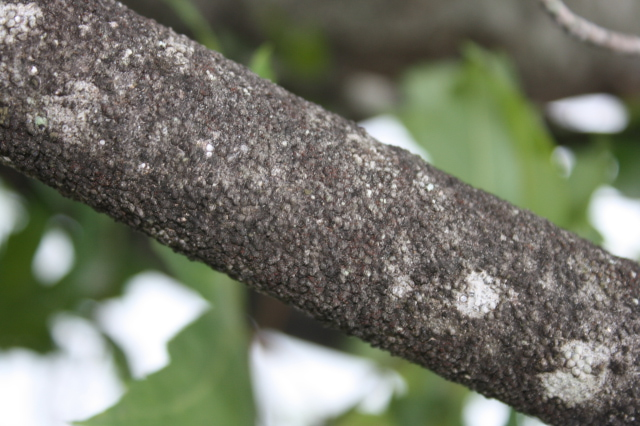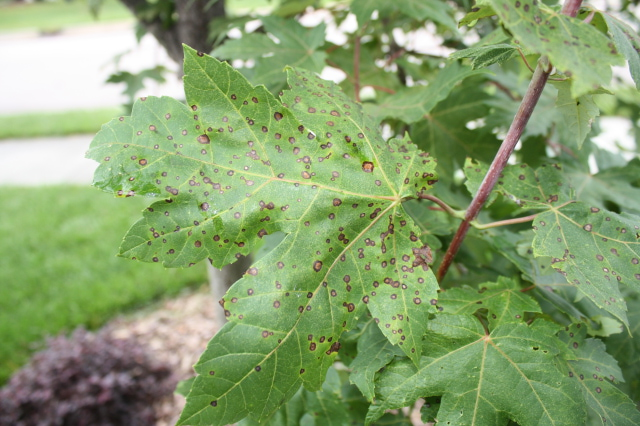Question
 branch
branch  leaf
leaf
I live in North Carolina and recently have had problems with Red Maple trees in our front yard. Some of the branches have lost some or all of it's leaves. Those branches have a dark rough coating (see close up pic). It appears to be spreading throughout the tree and to other trees. Some of the leaves have dark spots on them. We have also noticed our Japanese Maples, which are in the same area, are loosing some of it's leaves also. They do not have the dark coating on the braches but have a green colored growth on them.
Can you identify this problem and what can we do to rid the issue. Thanks.
AnswerLeaf problem
These are leaf spot caused by a fungus. I am going to guess it is Phyllostict leaf spot. A leaf spot that infects late in the growing season causes very little damage except maybe the leaves will fall earlier than normal. If you want to control the fungus the leaf surface would need to be sprayed with a fungicide in the spring. A large tree would be difficult to spray and in my opinion not worth the effort since the damage to the health of the tree is slight.
Phyllosticta Leaf Spot of Maple. Pathogen: Phyllosticta minima
Like many fungal leaf spots, this disease affects a number of maple species, most prominently Amur, Japanese, red and silver maple. The disease causes little damage because the infection is localized. Spots are roughly circular and develop into tannish spots with purple to red borders. Later in the season the spots often contain black fruiting bodies of the fungus arranged in rings inside the lesion. Although this disease is quite noticeable in the landscape, especially on silver and red maples, and causes concern among homeowners, damage is minimal and fungicides are rarely necessary. If fungicides are required use a labeled product containing mancozeb or chlorothalonil.
Most fungicides are sprayed early in the spring to prevent leaf spots. You could try a fungicide it should keep the spots from spreading but will not make the ones that are there go away. Check with your local nursery for a fungicide for leaf spots on trees.
Branch problem
This is lichens. They do not cause any problems with trees. Lichens are an example of a symbiotic relationship between algae and certain fungi. They are capable of producing their own food. The algae associated with the fungus is a green or blue-green alga. There are three forms of lichens based on growth patterns. Crustose are species that are closely pressed against the surface of the limb or trunk of dead or live trees. Foliose forms are leaf like or prostrate but are also tightly attached to the tree. Fruticose forms are bush like, erect or hanging. Although lichens are found in most areas of Texas, they are most noticeable in areas that have extended periods of high humidity.
The effect of lichens on a tree are only slightly detrimental. The plants are epiphytes. That is they derive their nutrients from the air and not from the plant on which they are growing. Although they are not parasitized, literature reports suggest that lichens do have a slight negative effect. The main concern is that lichens give a tree an un kept appearance. Presence of lichens also is a good indicator of a thin tree canopy. This often leads homeowners to conclude that lichens are the cause and not the effect of thin foliage. The best control for lichens is maintain the tree in good condition. This will insure a dense canopy which will shade the limbs and reduce photosynthesis. Without photosynthesis, lichens are not able to manufacture food needed for growth and development.







